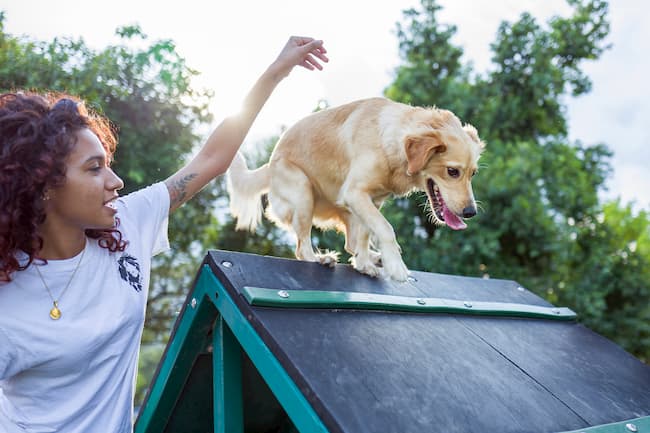How can you tell whether your dog is satisfied with the life they live? How can you, as a dog parent, provide your dog with a decent life? Unfortunately, our four-legged friends don’t know how to speak and cannot answer this question. So, let’s try to find the answer out ourselves.
Five freedoms as a term was introduced by the European school of behaviorism. Essentially it’s the concept of the fundamental welfare of an animal.
You can consider it to be something like the animal version of Maslow’s Hierarchy of Needs, otherwise known as Maslow’s Pyramid.
When we are talking about the five freedoms in the life of a dog, these are essential requirements that provide for the welfare of our animal.
And if we are talking about the correction of problematic behavior, The first thing we must do is to ensure that the five freedoms of an animal are met.
What are the five freedoms of a dog?
- Freedom from hunger and thirst.
- Freedom from illness.
- Freedom from discomfort.
- Freedom from pain and suffering.
- Freedom of the realization of behavior typical for the species.
What does all of this mean?
Freedom from hunger and thirst

This means that the dog must always have food and water. We know some people that leave water in the dog’s bowl for two-three days in a row, and the dog doesn’t finish it, and that’s simply not right.
We should always change the dog’s water. We recommend doing that at least twice a day. In the morning and in the evening.
If we’re talking about hot weather, for example, and the water warms up quite quickly, we would recommend changing it three to five times a day, so that the dog has an opportunity to drink nice cold water.
Freedom from hunger means that our dog must not feel hunger, but at the same time you’ve got to pay attention to the way you feed your dog.
We should never leave the food in the bowl for the whole day. This is a very important rule for the dog’s health and wellness. If the dog doesn’t finish the food in ten minutes, we take away the food bowl until the next meal.
This is important because it helps dogs get used to their daily schedules. Additionally, it is a great indicator of the dog’s state.
If the dog knows that there is always some food in the bowl, it can eat just a bit in the morning, then a bit more in the afternoon, and every time it approaches the bowl it’ll eat a bit of food and then go away.
This makes it hard to monitor the total amount of food eaten. However, by having a feeding schedule it’s easier to catch when your dog is sick because it refuses food.
If there is always some food in the bowl, and we know that the dog sometimes eats and sometimes doesn’t, and that it nibbles a bit throughout the day, it’s hard to know if your dog has a good appetite or not.
And then, quite often in these situations we only realize our pet is sick when things get really bad. At that point our dog is inevitably miserable and a visit to the vet is long overdue.
Also we need to be sure not to overfeed our dog. When we over feed our dog it can become overweight which can cause heart and mobility issues.
Overweight dogs can also struggle with diabetes along with many other issues. It’s our responsibility to provide our dog with the correct diet, nutrients and quantity of food.
Freedom from illness

This means preventive check-ups. We recommend visiting the vet once every six months in order to perform a check-up, get a general blood test, and evaluate the overall health and condition of your dog.
This is necessary in order to notice any health problems in time. And of course, if you think your pet might be sick, it’s not a great idea to wait around or try home remedies to treat them.
It’s the job of all responsible owners to treat their pet on time, so that it doesn’t suffer from pain or physical discomfort.
Freedom from discomfort

This means that our dog should have a reasonable level of physical comfort in our house—at least its own bed.
Even if the dog is allowed to lie on the couch, even if it sleeps with us in bed, it is very important for every room where the dog likes to spend time to have a dog bed, or something similar.
You don’t need to spend a bunch of money on extra beds. It could even just be a towel placed in an area which is warm and protected from drafts.
The dog needs to know this is also their home also and that they have their own personal space in the house, even if we may prefer having the dog sit next to us.
Freedom from pain and suffering

This means that we don’t leave the dog alone for a whole day. Studies show that dogs are comfortable with being left alone for six hours at a time.
If you do have to leave your dog alone for a longer period of time, say to go to work for 8 hours, it is recommended to get it a dog-sitter, dog walker, or nanny, so that it doesn’t feel uncomfortable and lonely.
This is another consideration—if your dog experiences anxiety when separating from you or fear when walking outside, it means the dog is uncomfortable, which in turn means it is experiencing pain and suffering.
When the dog doesn’t feel comfortable staying at home alone or going outside, our task as a responsible owner is to solve these behavioral problems on time, so that our dog feels calm and good.
Freedom of behavior typical for the species

This freedom refers to the fact that any breed of dog, at any age, must walk a minimum of three hours a day.
So, three to four hours is the perfect amount of time for a walk. This amount of walking helps the dog to get the physical and mental activity they need.
Obviously, if our dog is afraid of being outside, we shouldn’t make it walk for three to four hours. However this means that we are charged with the task of solving this problem so that our dog can enjoy its life.
The freedom of normal behavior also means that dogs must have the opportunity to socialize with other dogs especially during those puppy years of growth and development. But also when the dog is older. Even though Adult dogs often don’t play with other dogs.
They still need to have an opportunity to greet other dogs and then continue doing whatever they were doing, whether it’s playing, training or something else.
If our dog has a problem with aggression towards other dogs of course we are not going to let it off the leash in the dog park. We would be setting up for failure by expecting it not to engage species-typical behavior and fight with other dogs.
This becomes a challenge for us to try to find a solution.
Our dog shouldn’t have to feel the stress of being obligated to communicate and play with other dogs. That’s why it’s our job to teach them how to walk away calmly.
Barking is also a species-typical behavior. So, we can’t prohibit our dog from barking completely – this is its means of communication.
But of course we shouldn’t think in extremes. If our dog is constantly barking, vocalizing into the empty air, it’s a behavioral problem we have to solve.
To sum up here, we’re trying to avoid extremes and stick to the middle ground, to the standard we are pursuing.
Keep in mind that you got a dog to enjoy it as a dog. If we had wanted a little person, we would have got a little person. Let’s continue respecting the dog in our dog – a different species. And let’s try to understand what this species wants right now.
